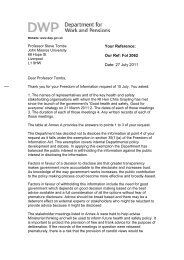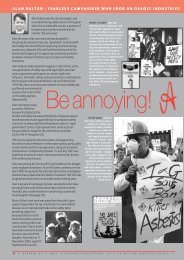Asian Asbestos Conference 2009 (AAC)
Asian Asbestos Conference 2009 (AAC)
Asian Asbestos Conference 2009 (AAC)
You also want an ePaper? Increase the reach of your titles
YUMPU automatically turns print PDFs into web optimized ePapers that Google loves.
Introduction and Background“….asbestos cancer epidemic may take 10 million lives worldwidebefore its probable global ban”- Joseph LaDou from the University of California“<strong>Asbestos</strong> is the most important single factor causing death anddisability at work, some 100,000 fatalities a year”“…every 170 tons of asbestos is responsible for one mesothelioma - afatal cancer of the linings of the lungs - and for two lung cancers.”- Jukka Takala, former director of ILO’s SafeWork programmeIt is not only unfortunate but gravely tragic to talk about the issue of asbestos in the year <strong>2009</strong>. Amajority of countries in west have either banned it or reduced its use to bare minimum owing to theunprecedented death and destruction that this previously believed ‘miracle mineral’ has caused. Themost logical step that rest of the countries could have taken was to simply ban this hazardous anddangerous substance that has killed and diseased thousands of workers and community membersglobally, continues to kill today and will kill for many more years even in countries that havecompletely stopped its use. On the contrary developing countries have been selectively targeted asan emerging market by the asbestos manufacturers and exporters. Asia has also emerged as one ofthe largest market for the asbestos consumption with China and India as two biggest consumers.Besides, Asia is also a major hub for ship breaking with places like Alang and Chittagong famous forits ship-breaking industry – where ships packed with deadly asbestos are torn apart by migrantworkers (with no protective equipments) who have no clue about the toxic environment they areworking in.Missing VictimsEven though large quantities of asbestos are being used in many <strong>Asian</strong> countries, yet the cases ofasbestos related diseases are hardly surfacing. Persistent use of asbestos in Asia also epitomises thestate of health and safety here, where profits attain priority to the lives of workers. It also shows thegrave problems of diagnosis in these countries. Very few doctors can correctly diagnoseoccupational lung diseases like silicosis and asbestosis, and they are routinely diagnosed or misdiagnosedas Tuberculosis, to diagnose Mesothelioma would seem out of question. The invisibilityof asbestos victims in this region can be attributed to this reason where thousands of exposedworkers might be dying quietly in their homes without proper diagnosis. Lack of proper diagnosis isalso key factor responsible for no or very few compensation cases on asbestos related sickness in theregion.Misinformation CampaignBoth International Labour Organisation and the World Health Organisation have clearly stated thatall form of asbestos are dangerous for human health and have advocated a complete ban on allforms of asbestos. However, the asbestos manufacturing lobby that in the past was led by theChrysotile Institute from Canada and now also aggressively promoted by Chrysotile Association led









